ECU PEUGEOT 2008 2013.5 User Guide
[x] Cancel search | Manufacturer: PEUGEOT, Model Year: 2013.5, Model line: 2008, Model: PEUGEOT 2008 2013.5Pages: 336, PDF Size: 9.23 MB
Page 151 of 336
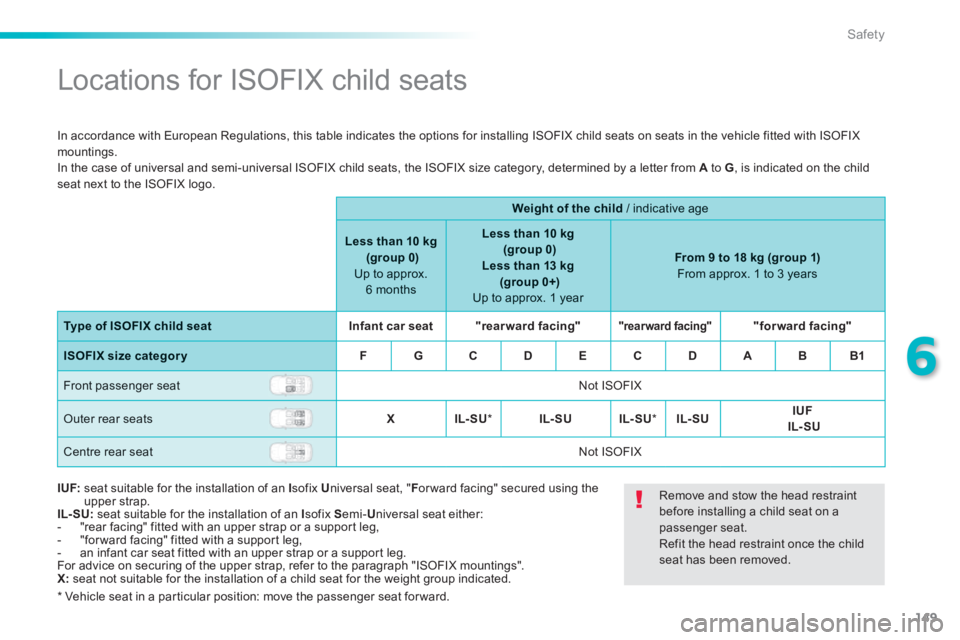
149
6
Safety
Locations for ISOFIX child seats
In accordance with European Regulations, this table indicates the options for installing ISOFIX child seats on seats in the vehicle fitted with ISOFIX mountings. In the case of universal and semi-universal ISOFIX child seats, the ISOFIX size category, determined by a letter from A to G , is indicated on the child seat next to the ISOFIX logo.
Weight of the child / indicative age
Less than 10 kg (group 0) Up to approx. 6 months
Less than 10 kg (group 0) Less than 13 kg (group 0+) Up to approx. 1 year
From 9 to 18 kg (group 1) From approx. 1 to 3 years
Type of ISOFIX child seatInfant car seat"rearward facing""rearward facing""forward facing"
ISOFIX size categor yFGCDECDABB1
Front passenger seat Not ISOFIX
Outer rear seats XIL- SU * IL- SUIL- SU * IL- SUIUF IL- SU
Centre rear seat Not ISOFIX
I UF: seat suitable for the installation of an I sofix U niversal seat, " F or ward facing" secured using the upper strap. IL- SU: seat suitable for the installation of an I sofix S emi- U niversal seat either: - "rear facing" fitted with an upper strap or a support leg, - "for ward facing" fitted with a support leg, - an infant car seat fitted with an upper strap or a support leg. For advice on securing of the upper strap, refer to the paragraph "ISOFIX mountings". X: seat not suitable for the installation of a child seat for the weight group indicated.
* Vehicle seat in a particular position: move the passenger seat for ward.
Remove and stow the head restraint before installing a child seat on a passenger seat. Refit the head restraint once the child seat has been removed.
Page 159 of 336
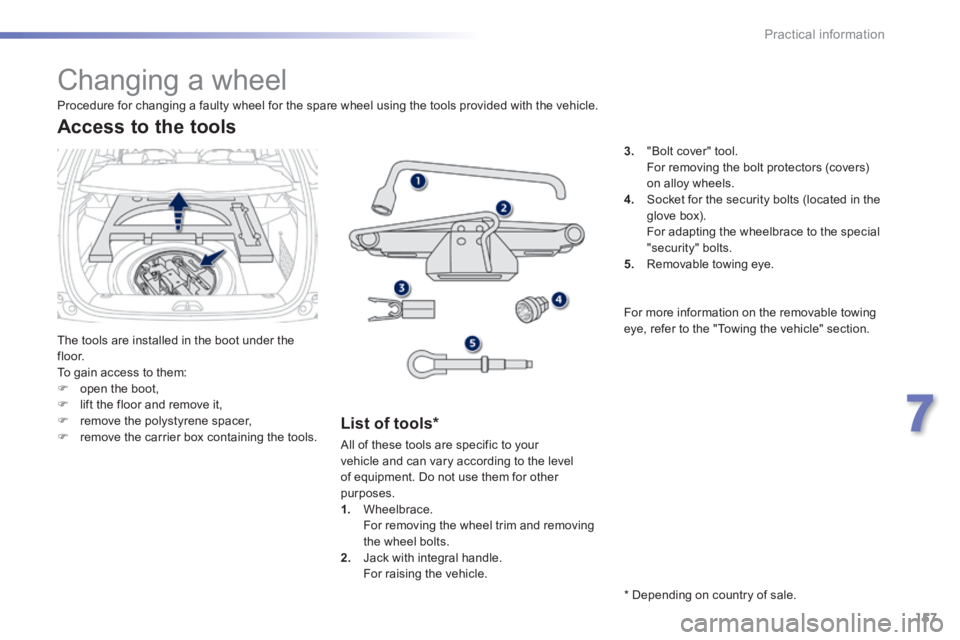
157
7
Practical information
Changing a wheel
The tools are installed in the boot under the f l o o r. To gain access to them: open the boot, lift the floor and remove it, remove the polystyrene spacer, remove the carrier box containing the tools.
Access to the tools
List of tools *
3. "Bolt cover" tool. For removing the bolt protectors (covers) on alloy wheels. 4. Socket for the security bolts (located in the glove box).
For adapting the wheelbrace to the special "security" bolts. 5. Removable towing eye.
Procedure for changing a faulty wheel for the spare wheel using the tools provided with the vehicle.
All of these tools are specific to your vehicle and can vary according to the level of equipment. Do not use them for other purposes. 1. Wheelbrace. For removing the wheel trim and removing the wheel bolts. 2. Jack with integral handle. For raising the vehicle.
* Depending on country of sale.
For more information on the removable towing eye, refer to the "Towing the vehicle" section.
Page 162 of 336
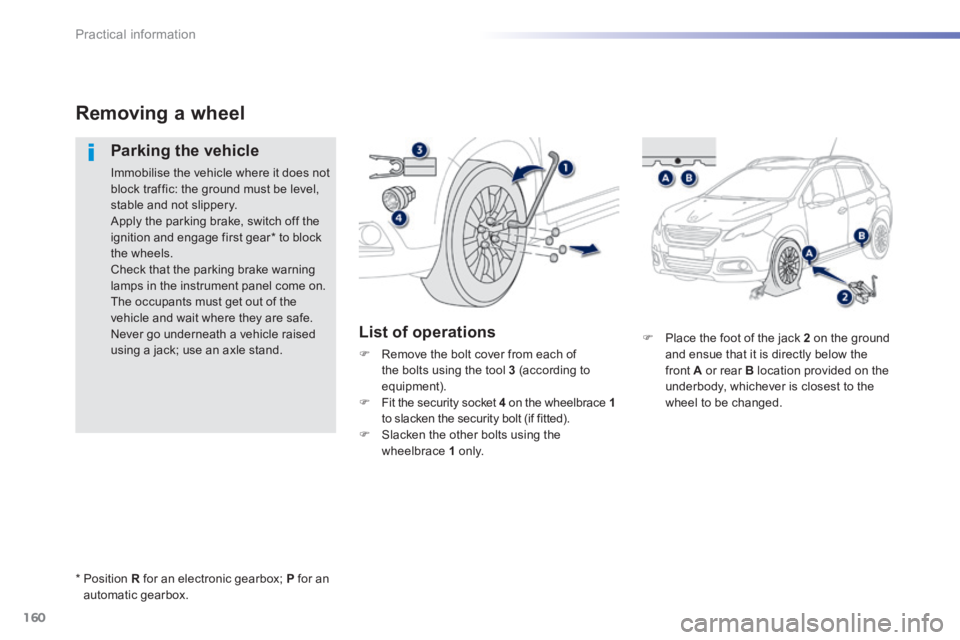
160
Practical information
Place the foot of the jack 2 on the ground and ensue that it is directly below the front A or rear B location provided on the underbody, whichever is closest to the wheel to be changed.
Removing a wheel
Parking the vehicle
Immobilise the vehicle where it does not block traffic: the ground must be level, stable and not slippery. Apply the parking brake, switch off the ignition and engage first gear * to block the wheels. Check that the parking brake warning lamps in the instrument panel come on. The occupants must get out of the vehicle and wait where they are safe. Never go underneath a vehicle raised using a jack; use an axle stand.
List of operations
Remove the bolt cover from each of the bolts using the tool 3 (according to equipment). Fit the security socket 4 on the wheelbrace 1 to slacken the security bolt (if fitted). Slacken the other bolts using the wheelbrace 1 o n l y.
* Position R for an electronic gearbox; P for an automatic gearbox.
Page 164 of 336
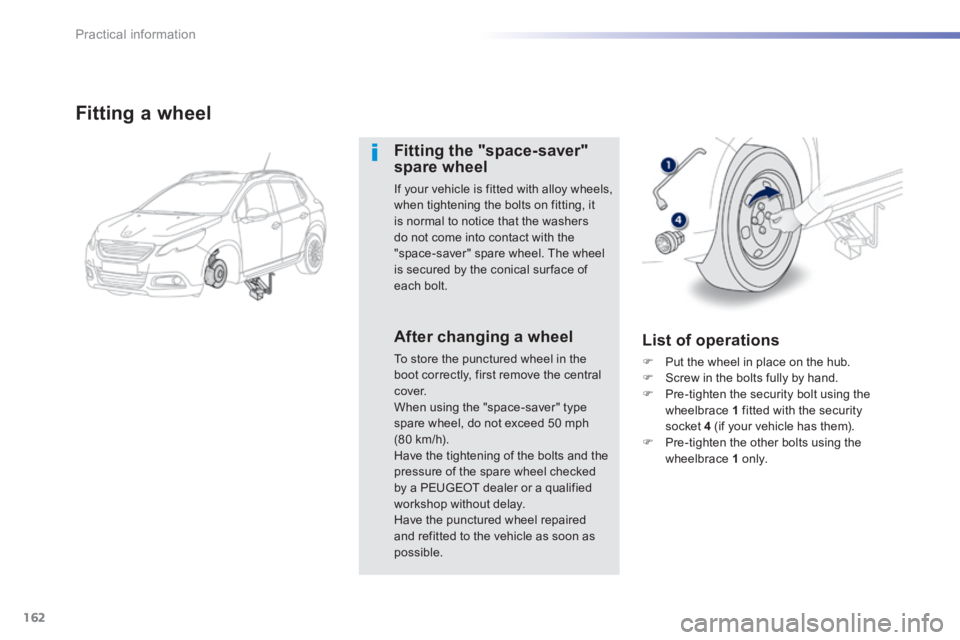
162
Practical information
Fitting a wheel
Fitting the "space-saver" spare wheel
If your vehicle is fitted with alloy wheels, when tightening the bolts on fitting, it is normal to notice that the washers do not come into contact with the "space-saver" spare wheel. The wheel is secured by the conical sur face of each bolt.
After changing a wheel
To store the punctured wheel in the boot correctly, first remove the central cover. When using the "space-saver" type spare wheel, do not exceed 50 mph (80 km/h). Have the tightening of the bolts and the pressure of the spare wheel checked by a PEUGEOT dealer or a qualified workshop without delay. Have the punctured wheel repaired and refitted to the vehicle as soon as possible.
List of operations
Put the wheel in place on the hub. Screw in the bolts fully by hand. Pre-tighten the security bolt using the wheelbrace 1 fitted with the security socket 4 (if your vehicle has them). Pre-tighten the other bolts using the wheelbrace 1 o n l y.
Page 165 of 336
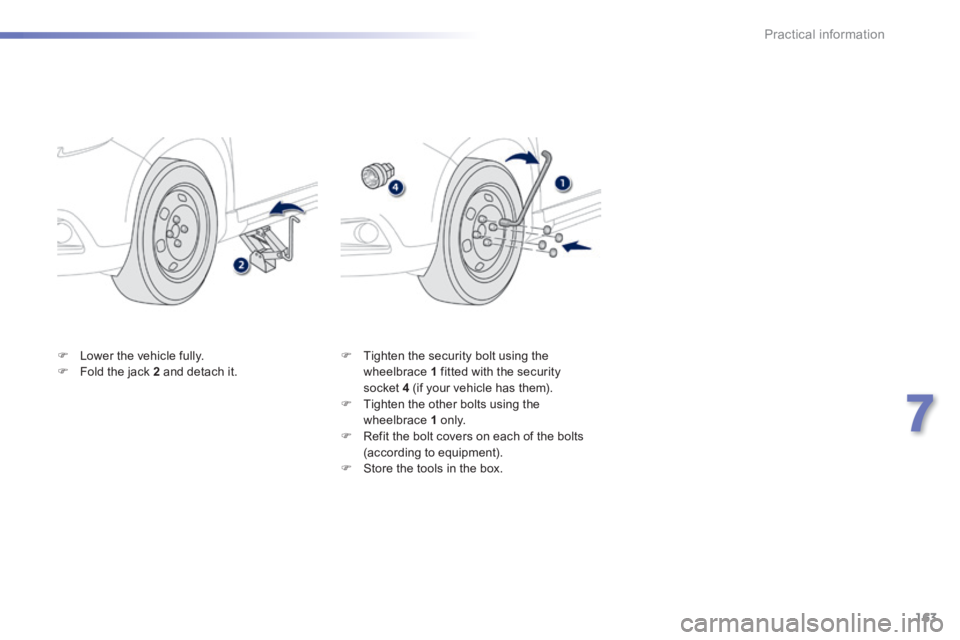
163
7
Practical information
Lower the vehicle fully. Fold the jack 2 and detach it. Tighten the security bolt using the wheelbrace 1 fitted with the security socket 4 (if your vehicle has them). Tighten the other bolts using the wheelbrace 1 o n l y. Refit the bolt covers on each of the bolts (according to equipment). Store the tools in the box.
Page 180 of 336
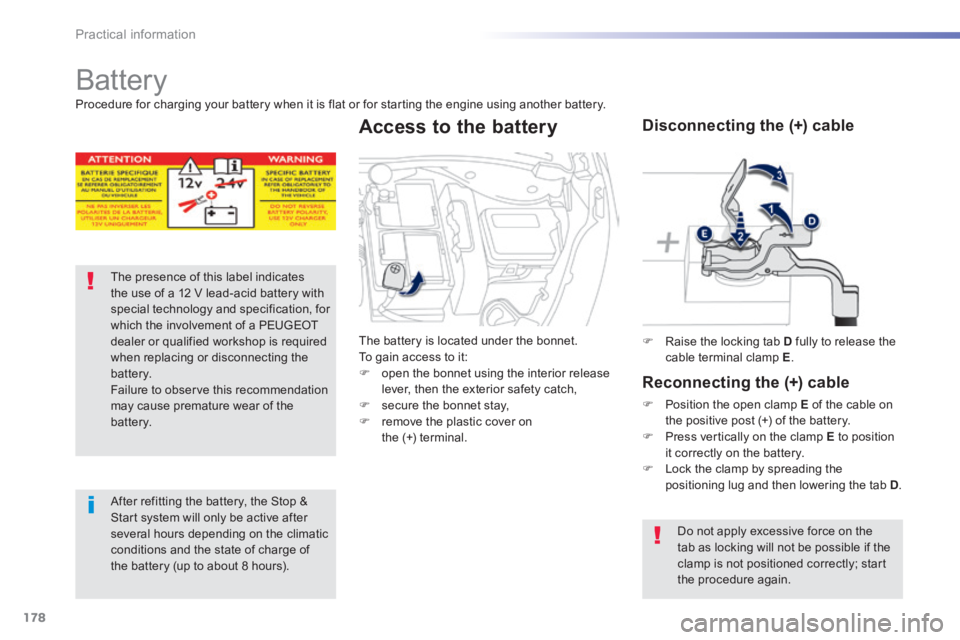
178
Practical information
Battery
The presence of this label indicates the use of a 12 V lead-acid battery with special technology and specification, for which the involvement of a PEUGEOT dealer or qualified workshop is required when replacing or disconnecting the battery. Failure to observe this recommendation may cause premature wear of the battery.
After refitting the battery, the Stop & Start system will only be active after several hours depending on the climatic conditions and the state of charge of the battery (up to about 8 hours).
Raise the locking tab D fully to release the cable terminal clamp E .
Disconnecting the (+) cable
Reconnecting the (+) cable
Position the open clamp E of the cable on the positive post (+) of the battery.
Press vertically on the clamp E to position it correctly on the battery. Lock the clamp by spreading the positioning lug and then lowering the tab D .
Do not apply excessive force on the tab as locking will not be possible if the clamp is not positioned correctly; start the procedure again.
Procedure for charging your battery when it is flat or for starting the engine using another battery.
The battery is located under the bonnet. To gain access to it: open the bonnet using the interior release lever, then the exterior safety catch, secure the bonnet stay, remove the plastic cover on
the (+) terminal.
Access to the battery
Page 190 of 336
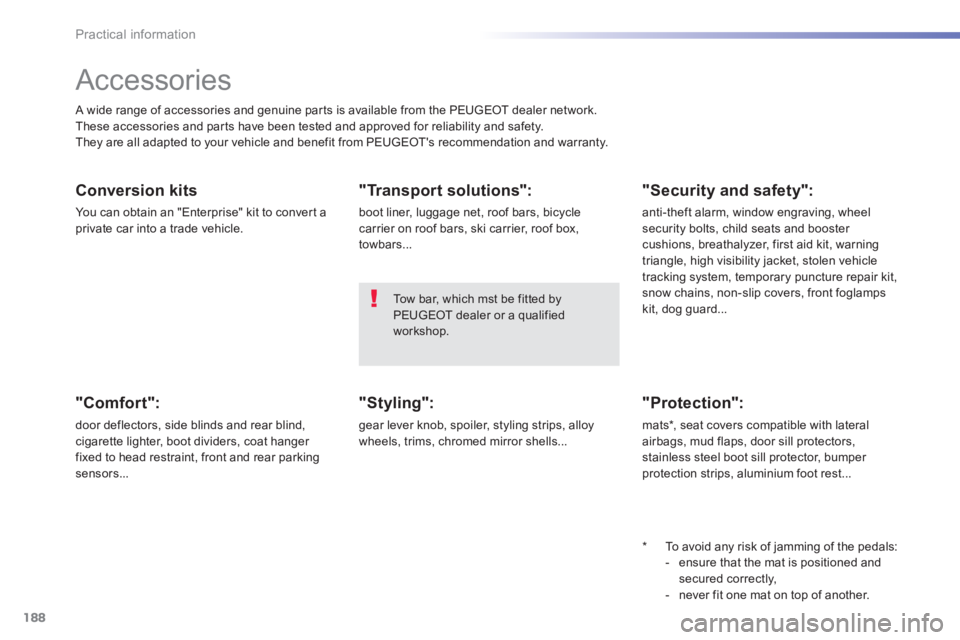
188
Practical information
Accessories
A wide range of accessories and genuine parts is available from the PEUGEOT dealer network. These accessories and parts have been tested and approved for reliability and safety. They are all adapted to your vehicle and benefit from PEUGEOT's recommendation and warranty.
Conversion kits
You can obtain an "Enterprise" kit to convert a private car into a trade vehicle.
"Comfort":
door deflectors, side blinds and rear blind,
cigarette lighter, boot dividers, coat hanger fixed to head restraint, front and rear parking sensors...
"Transport solutions":
boot liner, luggage net, roof bars, bicycle carrier on roof bars, ski carrier, roof box, towbars...
* To avoid any risk of jamming of the pedals: - ensure that the mat is positioned and secured correctly, - never fit one mat on top of another.
"Styling":
gear lever knob, spoiler, styling strips, alloy
wheels, trims, chromed mirror shells...
"Security and safety":
anti-theft alarm, window engraving, wheel security bolts, child seats and booster cushions, breathalyzer, first aid kit, warning triangle, high visibility jacket, stolen vehicle tracking system, temporary puncture repair kit, snow chains, non-slip covers, front foglamps kit, dog guard...
"Protection":
mats * , seat covers compatible with lateral airbags, mud flaps, door sill protectors, stainless steel boot sill protector, bumper protection strips, aluminium foot rest...
Tow bar, which mst be fitted by PEUGEOT dealer or a qualified workshop.